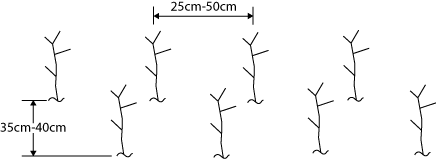Printed from: https://finalhbks.asgoodasready.com/planning-wildlife-hedge/
Before planting a wildlife hedge, consider its purpose. If the hedge is intended to be stock-proof, it needs to comprise at least 75% thorny plants. Hawthorn, with the addition of blackthorn or holly, often provides the mainstay of stock-proof hedges. Plants which provide berries or seeds for birds are desirable.
Planting hedgerow trees, such as oak or ash will attract more wildlife and, if allowed to grow, will provide shelter and shade.
Considerations
- Small plants (40-60cm tall) are cheaper, have a higher survival rate and often grow more quickly than larger ones.
- We recommend planting a double hedge. Plant a formation that staggers the plants in opposite rows so that as growth occurs, gaps will be filled. A distance of 25-30cm is recommended between plants and between rows.

Numbers of plants needed
To estimate the number needed, measure the length to be planted and allow the following:
100 metre double row stockproof hedge using 8 plants per metre = 800 trees
- 600 hawthorn (at least)
- 10 holly
- 50 mixed trees (ash, oak, crab apple, rowan, etc.)
- 100 blackthorn
- 40 hazel
This is a typical mix, but other native species can be substituted.
Some people suggest planting dog rose in the initial mix (instead of some of the mixed trees perhaps), but they can grow quickly, although it’s easier to plant them at the beginning than to add them later!
To keep the cost down and to produce an effective hedge, the 600 hawthorn (or even more) should always be planted.
Planting tips
- Make sure plants are well watered before applying a 2 inch layer of mulch to suppress weeds. This is only practical on small hedgerows.
- Where possible, trim plants to approximately one third immediately after planting. This sounds drastic, but it encourages strong, bushy growth.
The plants will respond according to the preparation made at the time of planting, and also to the watering, feeding and weeding carried out in the first few years.

